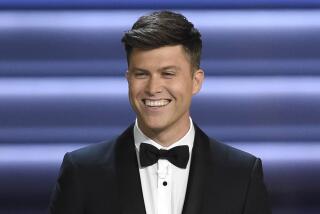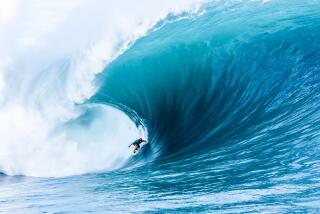America’s Cup Competition : Doctor Charting New Course to Care for Team
- Share via
Would the San Diego Chargers want quarterback Dan Fouts to be examined by the San Francisco Forty-Niners’ doctor during a game in the Bay Area? Not likely. The Chargers take their own team physician on road trips.
So what about the medical needs of San Diego’s Sail America racing team, half-way around the world off western Australia during a six-month competition beginning in September to regain the America’s Cup? Would the crew competing for the symbol of world sailing supremacy get an equal crack at quick medical treatment in competition with their Australian opponents, who will be in home waters making their first defense of the cup?
Concern for the Sail America crew during its 18 months of grueling work--six days a week, 10 hours a day--led Dr. Thomas Kravis of Mercy Hospital to volunteer in February, 1985, to devise a health care plan for the San Diego-based organization.
What Kravis did not realize was that he and his colleagues would themselves be sailing into uncharted waters in providing needed services. A year later, his work now involves not only treatment of sailing-related injuries--common and not-so-common--but matters of diet, fitness and equipment to prevent injuries. And Kravis, director of Mercy’s emergency care, has expanded his planning to include crews of several other American teams that will be vying for the challenger’s position against the Australians.
“We need the potential to be medically independent if, for some reason, medical services become part of the sailing competition,” Kravis said in an interview. In the high-pressured series of daily races of 12-meter sailboats over the six-month period, crew members will need immediate medical attention so that they will not be lost for several days and miss crucial races.
Based on a trip last month to the America’s Cup site at Fremantle, Australia--19 miles from the city of Perth--Kravis said there may well be competition for doctors. When Kravis suggested to the Australian physician in charge of the Down Under team that all competitors cooperate on health care, he received a polite turndown, with an added touch:
“By the way, we are going to keep the Cup.”
The man heading the official Australian government planning office for the races told Kravis that “it would be naive” to think that even rival American teams will cooperate in the heat of competition.
“Only time will tell,” Kravis said. For the moment, Kravis plans to head up a medical mission that will plant itself in Fremantle from September to February, with--at the minimum--a doctor available 24 hours a day and necessary medical equipment for all American crews. If he can arrange U.S. corporate or hospital sponsorships of $150,000 or more, Kravis would like to include a nurse paramedic, a full-time sports medicine physician who is expert in rehabilitation, and a compact testing laboratory. (The Quidel pharmaceutical firm agreed Monday to fund kits that diagnose a strep throat within minutes, rather than three days under normal lab testing.)
“My heart is with the Sail America group,” Kravis said. “But I’ve talked to (San Diego sponsor) Malin Burnham about the other (American) crews and he said no problem, that he supported serving them as well. Right now we’ll treat anyone regardless of crew or origin.”
Kravis now can field a skeleton crew of 10 doctors (most from the Mercy emergency department and willing to serve without salary and pay their own way to Australia) spending two or three weeks each in Fremantle. In addition, he has lined up about a dozen Australian specialists in Fremantle and Perth--a dermatologist, a neurosurgeon and an ophthalmologist among them--to be on call. The only hospital in Fremantle has agreed to supply needed drugs and medical supplies at cost.
“One of the difficulties is that these guys will begin sailing at 9 in the morning and not finish up before 6 p.m.,” Kravis said. “So there could be a potential crunch with 300 to 400 crew members from all the syndicates coming in before 9 or after 6 for their medical problems. And if a single rehabilitation takes 45 minutes, you can’t take care of 400 guys the same day.”
Most problems will be muscle- and skeletal-related, Kravis said. Already, the Sail America team practicing in Hawaiian waters has encountered tendinitis of the elbow, knee problems, head lacerations from banging into equipment and eye injuries.
“There is only one whirlpool in all of Fremantle,” Kravis said, noting the importance of such a machine for quick rehabilitation of bruises and muscle pulls. “Having our own would be very, very important.”
Kravis is worried more about preventing injuries, and about providing everyday care for aches and pains and minor infections, than about the availability of specialists.
“These sailing guys, for the most part, are not athletes,” Kravis said. “In testing of body fat, blood, oxygen utilization, we gave (the Sail America crew) last July and August, we found many needed to improve their physical fitness and, in some cases, medical fitness.”
Kravis, along with several Mercy doctors, drew up fitness and nutrition programs to put the entire Sail America crew into better shape to withstand the rigorous competition. (Kravis has even procured a supplier of whole grains and fresh fish in Perth for the time of the races.)
Kravis has had to come up with programs from scratch by talking with physicians nationwide since there are no established sports medicine protocols for sailing. He learned from an expert trainer of rowing teams in Mississippi that necessary endurance and upper-body strength could be built by having the crew use their hands to turn the pedals on exercise bicycle.
Already, in Hawaii, the combination of wind and salt air has created dry-eye problems. Heavy waves have slammed some crew members into bulkheads, causing scalp cuts and at least one concussion.
Kravis is hoping for funds to design a lightweight helmet and protective gear for knees and elbows. Along with a Stanford expert in ergonomics, he is looking into redesign of the apparatus called the “grinder” that unfurls the sails so that crew members who turn it can reduce or eliminate elbow tendinitis.
All Sail America members have been given psychological tests as well. The results are known only to Kravis and the psychologist who administered them.
“The results allow us to work with the crew to emphasize those traits that are positive and help (moderate) those that are weaknesses,” Kravis said, although he said that Sail America head Dennis Conner has chosen a group that works together well.
Despite the competition with Australia, Kravis said that at the conclusion of the races next February, he and his Australian counterparts will sit down and exchange information on training and health.
“The result will, hopefully, be a scientific paper on how to prepare for 12-meter medicine,” Kravis said.


